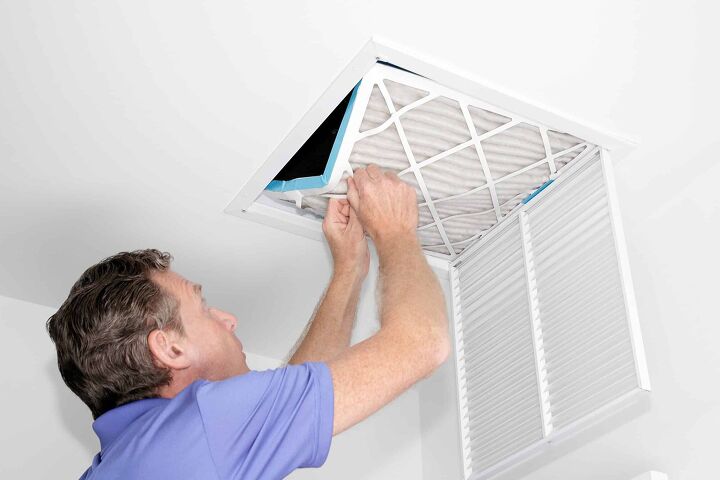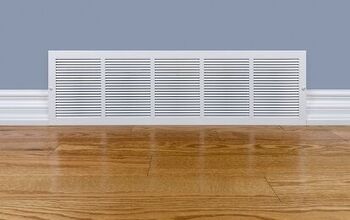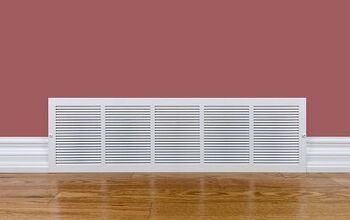Should I Put A Filter On My Return Vent?

Have you ever looked up into your return vent and seeing something dark and gross looking? You open up the return vent and find this dirty filter covered in stray hair dust and debris. But, is this helping the vent, or is it making things worse? Should you even put a filter on your return vent?
You should put a filter in your return vent near the return bank connection at the air handling unit. The return vent filter will keep the air clean and remove particles that lead to poor air quality. Install a filter for your return vent to clean the air inside your home.
We’ll give you a little bit more info on why filters are essential. We’ll also explain what types of filters are available and how you can choose the correct one for your home. That way, you know what to do and don’t get lost along the way.
Do You Need Air Duct Cleaning Services?
Get free, zero-commitment quotes from pro contractors near you.

Should You Use A Filter In Your Return Vent?
Return vent filters are recommended for most dwellings. They usually don’t harm your HVAC system and are simple to install without the help of an HVAC specialist.
Return vent filters, in addition to having a good main filter, can alleviate this problem instantly by placing one on the vent.
Check to see if your air conditioner is having trouble getting air through the vents in the first place; if it is, the filter could be obstructing your airflow. However, if your air conditioner is in good working order, it’s more than ready for a return vent filter upgrade.
Why Are Vent Filters Recommended?
- Quick installation — Your vent filter may be installed in a matter of minutes.
- Immediate outcomes – Return vent filters aren’t dangerous to your HVAC system. It simply cleans the air that flows through your home’s central HVAC system before it enters your home. You’ll notice an immediate improvement in air quality, especially if you use them on all of your vent grilles. Simply remember to replace them on a regular basis (approximately once a month), especially if they become too unclean.
- Vent filters are useful for more than just air conditioners; they can also be used on fans and heaters, as long as the filter isn’t too close to the heat source. If you have a forced-air heater or air conditioner with duct tubing, try installing a filter on the return vent to reduce the dust that these systems are known to spread.
When Shouldn’t You Use A Filter On A Return Vent?
Return vent filters may not always be enough to solve problems with an AC system. This could be due to duct leaks or inadequately sealed tubing. There are no filters that can solve the problem in this scenario.
A vent filter won’t work if the duct inside has been eroded, because air could pass through the aperture. Any problems with your furnace or air conditioner may prevent air from properly passing through the vents, causing it to work harder to heat or cool your home.
To summarize, before installing a return vent filter, be sure that your system and vents allow for proper airflow.
What Are The Benefits Of Return Vent Filters?
Return vent filters have a number of advantages. Here are a few of their main advantages:
- Easy to replace — Return vent filters are significantly easier to replace than primary filters because of their placement. Because many homes’ HVAC units are located in the attic, you won’t have to make as many excursions up there to change the filters.
- Protection for the primary air filter – Using a return vent filter will help your HVAC unit’s main air filter last longer. Any dust and debris will be pre-filtered by the filter in your return vent. This extends the life of your HVAC unit’s pricey pleated air filter.
- Incoming particles such as hair and dander may clog your ductwork if you have pets. The use of a return vent filter kit will help to filter out pet hair before it reaches your home’s HVAC system.
- Ductwork protection– Return vent filters to keep dust and hair from entering your HVAC ductwork. Have you noticed dust accumulating in your ducts? Covering the return grill with a vent filter is the simplest approach to solve this problem.
- The first line of defense – Vent filters serve as the first line of defense against contaminants in the air that circulates throughout your home. Ordinary filters have their place, but in some cases, a backup on your return vent to pre-filter the air in your home may be required.
How To Place Your Filter On Your Return Vent
Step 1: Turn Off The Unit
First and foremost, you will need to turn your unit off. Turning the unit off will prevent any dust or dirt from blowing into your system and throughout your house.
When you remove the old filter, the dust may drop so that you can sweep this out relatively easily. However, if your system is still on, it will blow it throughout your duct system.
Step 2: Remove The Used Filter
Unscrew the vent using the screwdriver, usually flat head, so that you can access the used filter. Simply remove the old filter and toss it in the garbage.
Make sure you pay attention to exactly how it was in there so you can replace the new one in the same way.
Step 3: Check The Air Flow Arrows
Before moving on, you need to ensure that the airflow arrows are going towards the HVAC unit. If not, then adjust it to where they are so that your system’s filter functions correctly.
Step 4: Install The New Filter
Now, you can install the new filter. This is extremely easy, and you don’t need a professional to do it. Then, replace the vent cover and screw it into place.
Step 5: Turn Your Unit On
Now that you’re finished turn your unit back on and enjoy the fresh air.
What Exactly Do Filters Do?
When you look around your home, it’s easy to think that the air in your home is fairly clean. When you look at your air filter, you might be shocked by all of the build-up on it.
As people and pets come in and out of your home, they carry with them dirt, pollen, and other contaminants from the world around them. Over time, these tiny particles in the air start to collect on that filter.
Without a filter on the return vent, all that dust and debris would just be recirculated back into your home. You’d see more dust on your bookshelves and might experience symptoms of allergies and breathing problems.
Filtering Outside Air
Sometimes the filter also filters fresh air provided into your home. Fresh air can come from open windows and doors, but occasionally fresh air is ducted into your home. Fresh air is essential for preventing mold and mildew.
Bugs, birds, leaves, and sticks may get inside that fresh air duct. The filter can keep out of your home. Large debris can get sucked up into your unit and damage the coil or motor inside your unit.
Where Do Filters Go?
Most home heating and cooling units have a single filter in the return vent. The vent might be located in a central location in your ceiling or close to the unit. Some homes have vertical units in a closet where the return vent is located on the door.
Most current building codes require a filter on your HVAC unit. This filter filters both the fresh air and the recirculated air from your home.
The Difference Between Supply And Return Vents
You can tell if a vent is a supply or return vent by holding your hand over it. You should be able to feel the draft pushing against your hand if the vent is a supply vent. Return vents are usually much more extensive and suck air into them.
You may not feel much of a draft through the return vent even when the unit is on. You may even hear more noise out of the return vent since it’s often closer to your HVAC unit.
What Filter Do I Need For My Return Vent?
Shopping for new filters may seem like a daunting task. There’s a range of options in different efficiencies and different sizes. Take notes of the dirty filter that you are trying to replace.
The filter should have the size printed on it. The label should give you the height and width of the filter, but also depth. Most home filters are about 1 in thick.
You should always make sure that your new filter will fit snugly in the existing filter location. If your old filter wiggles around or has gaps around it, it may be the wrong size. Carefully measure the location of the filter to see what the largest one that will fit might be.
Different Types Of Filters
Most home filters are disposable, pleated filters. A cardboard frame holds the saw tooth filter material. You may even find reusable or washable filters.
However, these types of filters generally aren’t as high efficiency as disposable ones. Some filters even have carbon embedded in the fibers, which can help eliminate odors. This could be helpful if you live with pets or cook a lot.
Efficiency Ratings
Even if you already know the size of your filter, you will still have many options for efficiency ratings. Higher efficiency filters can filter out smaller particles, like smog or odors. Low-efficiency filters can only filter large objects like pet hair or large dust particles.
You want to buy the most efficient filter that your HVAC unit can handle. This will make the indoor air in your home feel fresh and healthy.
Some states now require that new homes have a MERV-13 filter. MERV is a rating program that tells you how efficient your filter is. Higher numbers are more efficient than lower numbers.
Filters Impact Your Unit’s Performance
However, some older units can’t handle a high-efficiency filter. A higher efficiency filter is denser, which requires more power from the unit to pull the air across it. Check out our article about poor performing furnaces to read more.
If you put in a high-efficiency filter can cause your unit to perform worse. You may need to replace the filter with a lower efficiency filter. Poor performing units can cause all sorts of sounds that you can investigate.
High Tech Filters
There are tons of options for High-Tech filters:
| Filter Type | Filter Purpose |
| UV Lights | Disinfect germs and viruses from the air stream |
| Electrostatic | Ionize air particles to remove them from the air. |
| HEPA Filters | High density, thick filters used in many healthcare settings |
If you purchase an electric filter device, make sure you review Consumer Reports. Some electrostatic filters can produce ozone. While they may make your home smell like baking bread, ozone can be harmful to brain function.
How Often Should I Change My Filter?
No matter how efficient your filter, you must change it often. As dust and debris build up on your filter, it becomes less efficient. It also becomes more challenging for the unit to pull air across the filter.
Filters should be replaced every 1-3 months, depending on your filter and HVAC unit.
However, you should check the directions on the filter you bought and your units’ operations manual. Always follow what the manufacturers suggest you do. If you don’t maintain your unit correctly, you might void any warranty you have remaining on your unit.
Do I Need A Filter?
Filters are an essential part of your home. If you’ve never checked your filter, we recommend you go ahead and take a look now. You may need to grab a screwdriver to remove the return vent cover.
If you don’t have a filter in your return vent, check the cabinet of your unit. There may be an access panel you can open to look and change the filter inside.
If you can’t find a filter anywhere between the return vent in your unit, you may need to hire a mechanical contractor to install one for you.
Don’t Ignore Your Filter
After you changed your dirty filter, set a reminder on your calendar to change it every 1-3 months. If you experience bad air quality, like a wildfire or a storm, you may want to change it earlier.
Some areas just have worse air quality than others. You may not even run your unit very often. Still, try to take a look at your filter regularly to ensure that it’s not getting clogged up.
Do You Need Air Duct Cleaning Services?
Get free, zero-commitment quotes from pro contractors near you.

Wrapping It Up
Everyone should have a filter on their return vent. This will help to keep the airflow clean and healthy. Check your filter every month to ensure that it’s clean.
If it’s not, take the time to replace it with a clean one. This project is very simple to do yourself. No need to hire a professional!

We are a team of passionate homeowners, home improvement pros, and DIY enthusiasts who enjoy sharing home improvement, housekeeping, decorating, and more with other homeowners! Whether you're looking for a step-by-step guide on fixing an appliance or the cost of installing a fence, we've here to help.
More by Upgraded Home Team














![10 Best Electric Lawn Mowers - [2022 Reviews & Top Rated Models]](https://cdn-fastly.upgradedhome.com/media/2023/07/31/9070486/10-best-electric-lawn-mowers-2022-reviews-top-rated-models.jpg?size=350x220)












